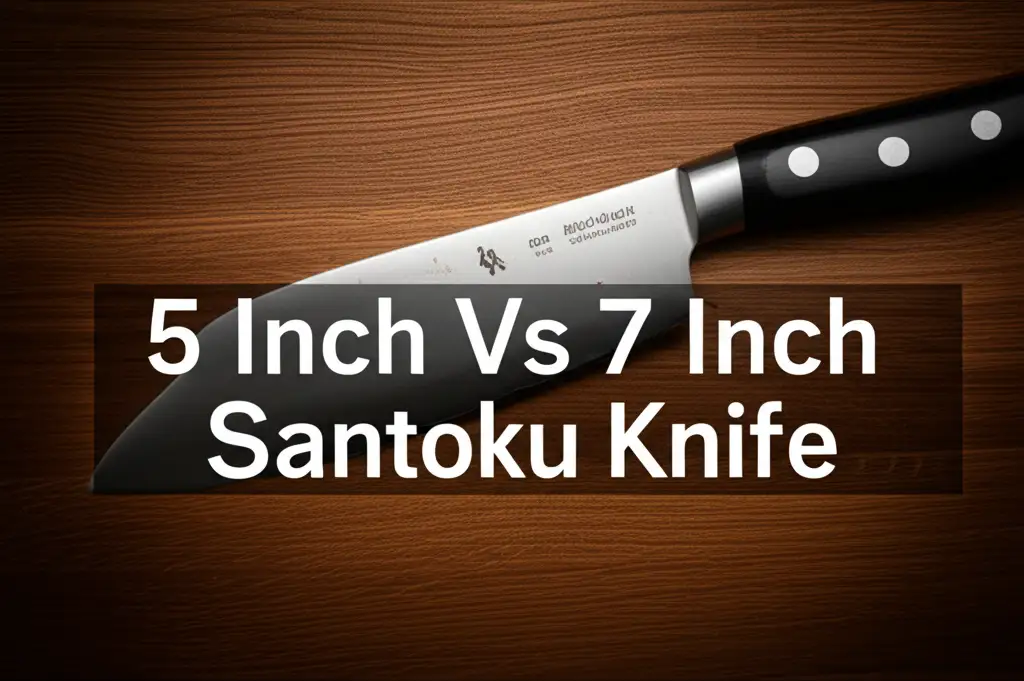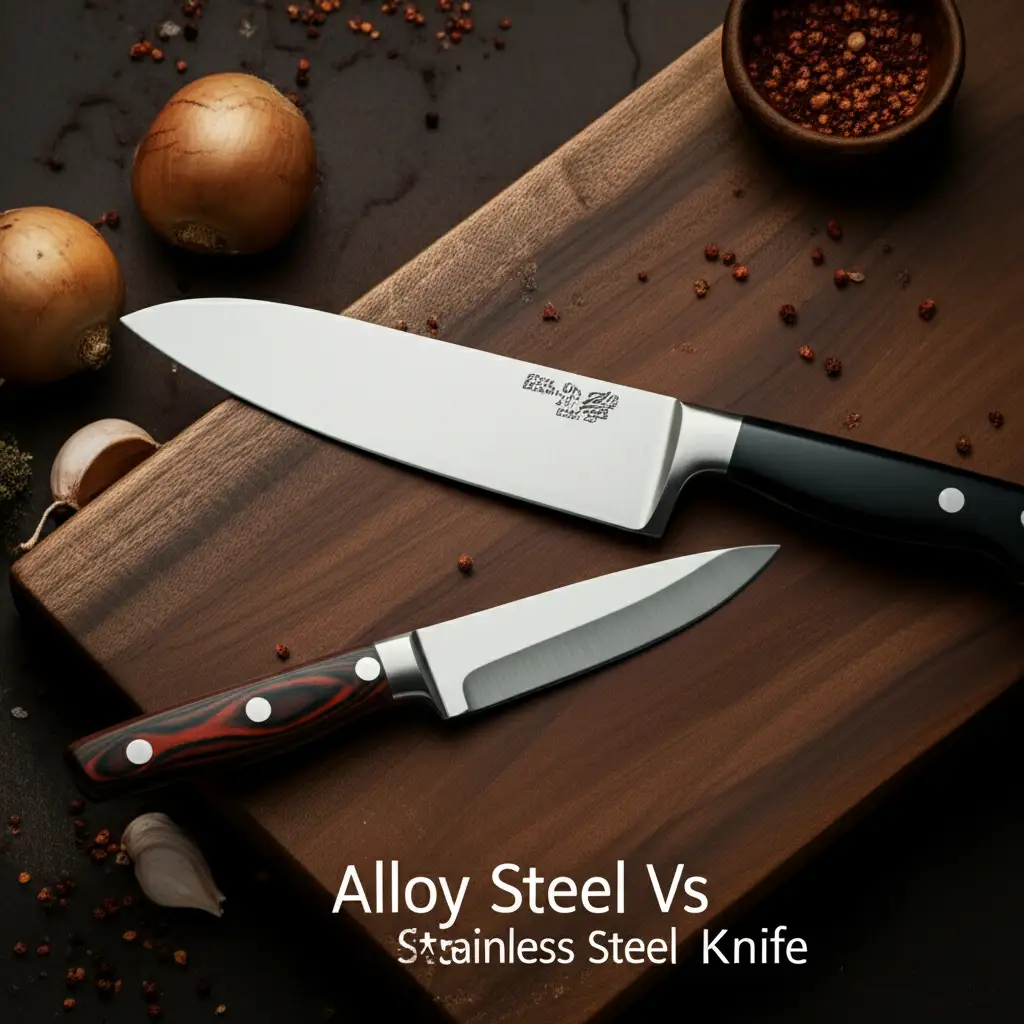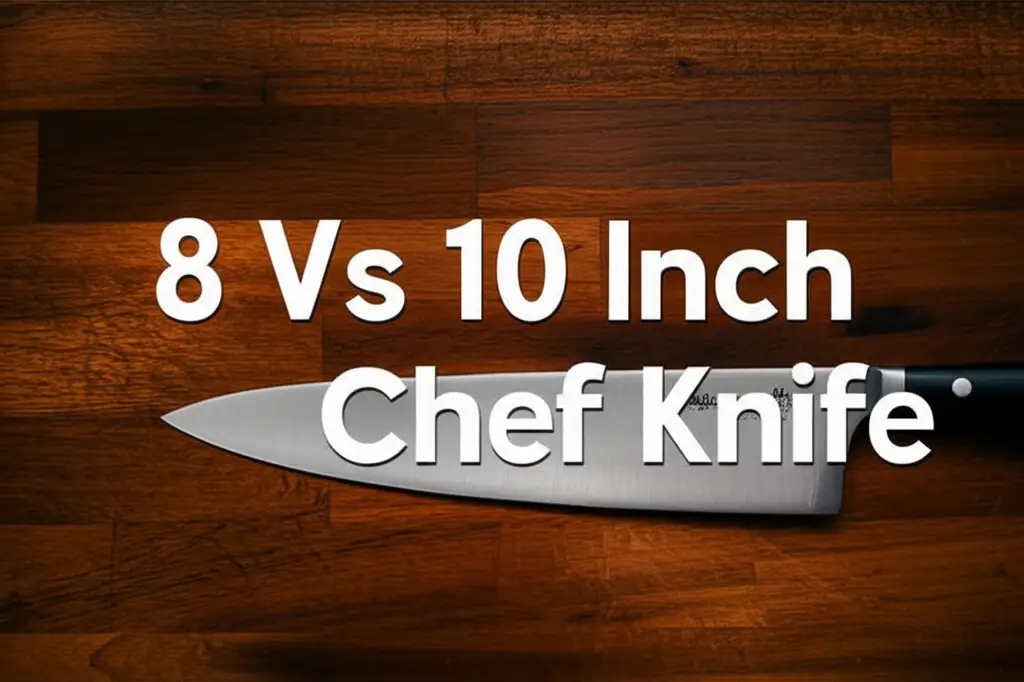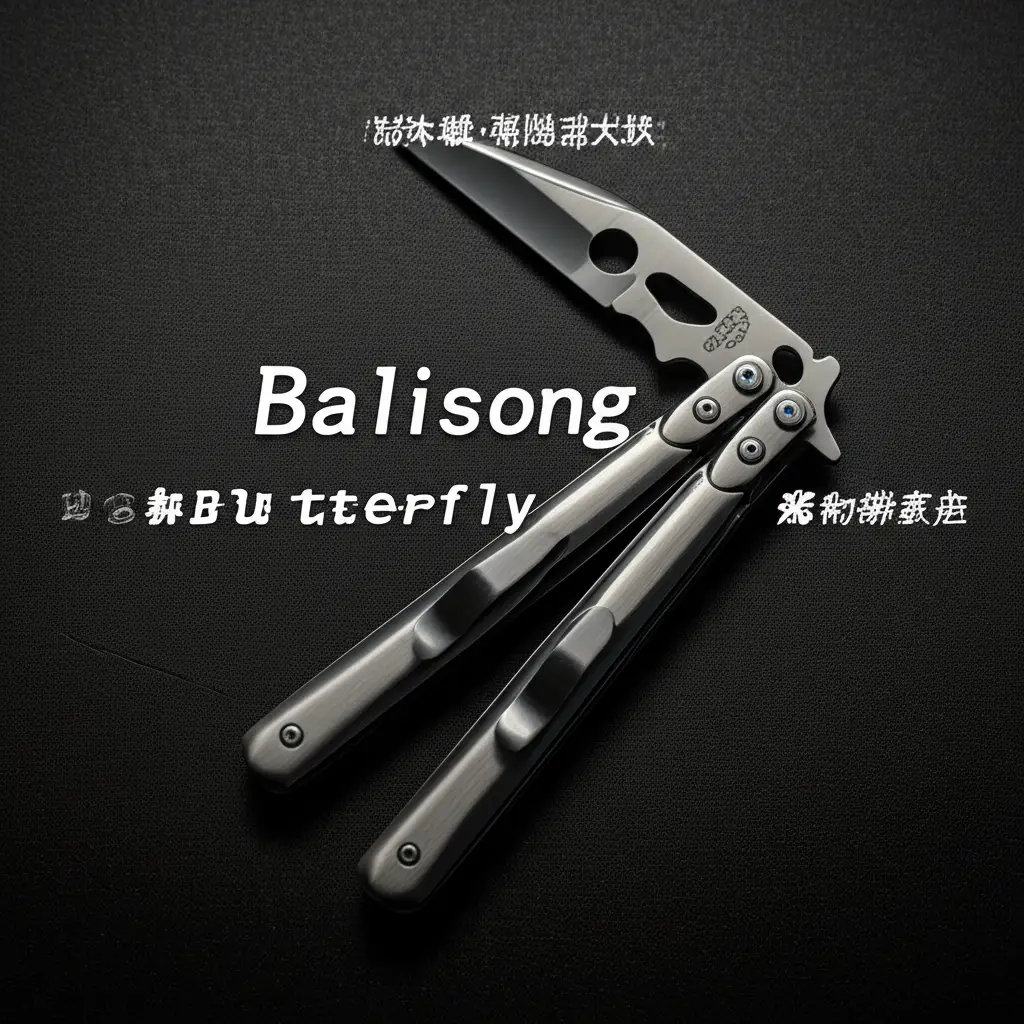· Elira Thomsen · Kitchen Knives · 16 min read
Asian Vs Standard Knife
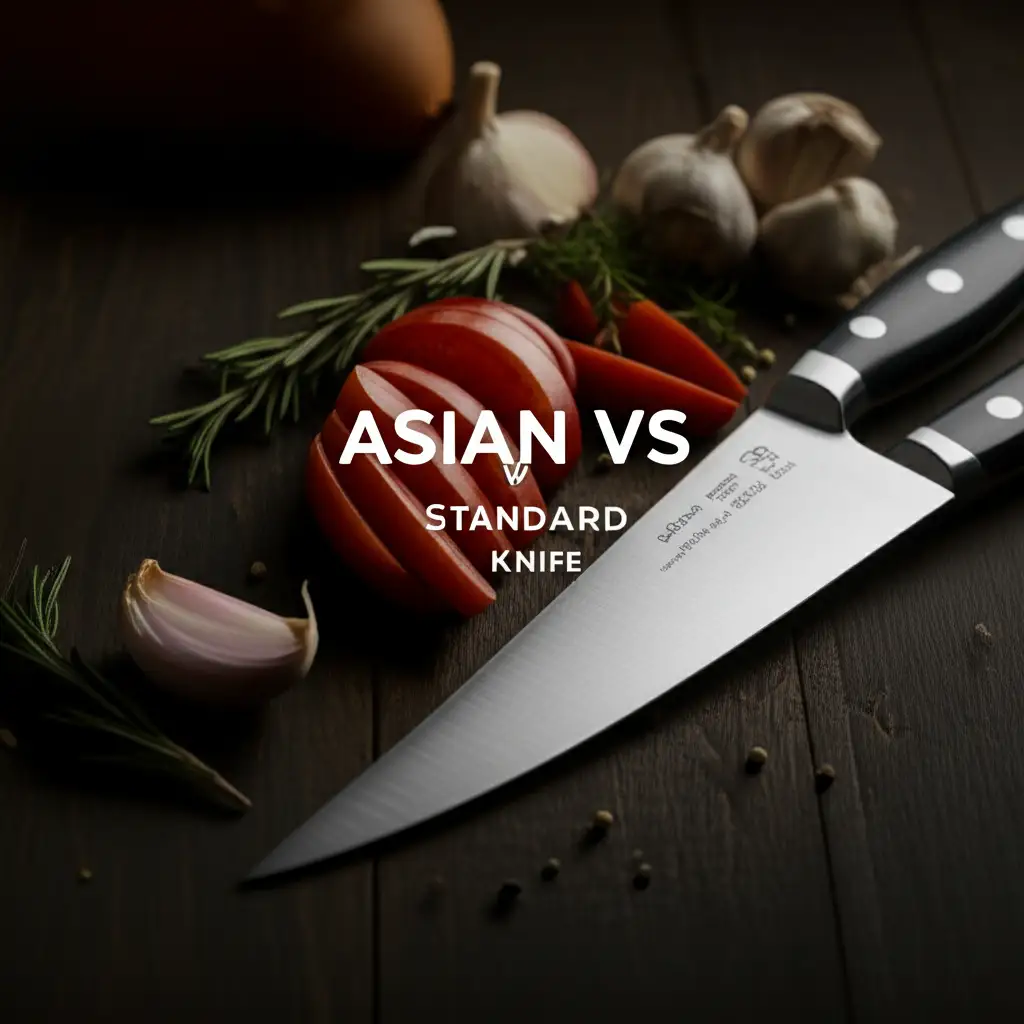
Asian Vs Standard Knife: Choosing Your Blade for Culinary Mastery
Every home chef dreams of effortless cuts and precise kitchen work. Often, the right knife makes all the difference. When you look at kitchen tools, you quickly see two main categories of knives: Asian knives and standard kitchen knives. People often wonder about the specific differences between these two types.
This article will help you understand “Asian Vs Standard Knife” better. We will explore their unique features, typical uses, and sharpening needs. By the end, you will know which knife best fits your cooking style. You will also learn how to pick the right blade for every task. Let’s dive in and uncover the distinct world of Asian and standard kitchen knives.
Takeaway
- Blade Geometry: Asian knives have thinner, sharper blades with a smaller angle, while standard knives are thicker with a wider edge angle.
- Cutting Motion: Asian knives excel at push-cutting and fine slicing. Standard knives are better for a rocking chop.
- Handle Style: Asian knives often feature traditional wooden “Wa-handles.” Standard knives typically have ergonomic Western-style handles.
- Steel Hardness: Asian knives often use harder steel for better edge retention. Standard knives use softer steel for toughness and easy sharpening.
- Maintenance: Sharpening Asian knives requires more precision, often with whetstones. Standard knives are more forgiving.
Asian knives feature thinner, sharper blades with a steeper cutting angle, designed for precise, fine cuts using a push-pull motion. Standard knives often have thicker blades with a more robust edge, suited for a rocking motion and general-purpose chopping and slicing tasks in the kitchen.
Understanding the Blade Geometry: Asian Knife vs. Standard Knife
When you hold a knife, the first thing you notice is its blade. The shape and thickness of a knife’s blade tell you a lot about its intended use. There are clear differences in how Asian knives and standard knives are built. These differences directly impact how they perform in your kitchen.
Asian knives, like the Santoku or Nakiri, generally have a much thinner blade. This design allows them to glide through food with minimal resistance. Their edge angle is also very acute, often between 10 to 15 degrees per side. A smaller angle means a sharper edge. This acute angle helps with very precise and clean cuts. The blade often has little to no belly curve, especially with Nakiri knives which are flat. This flat profile is good for direct downward cuts. It ensures full contact with the cutting board.
Standard kitchen knives, such as the Western-style chef’s knife, typically have a thicker spine and a more pronounced curve, or “belly,” along the cutting edge. Their edge angle is usually wider, around 20 to 25 degrees per side. This thicker, more robust edge is less prone to chipping. It holds up better to tougher tasks. The curve of the blade makes a rocking motion natural. This motion is good for quickly mincing herbs or chopping vegetables. Both types of knives have their strengths based on their unique blade designs. Choosing between an 8 vs 10 inch chef knife for a standard knife or a 5 inch vs 7 inch Santoku knife for an Asian knife depends on the specific tasks you plan to do most often.
The Asian Blade Profile
Asian knives often have a straighter edge profile. They are designed for precision work. Their thin blades cut through ingredients with ease. This design makes them excellent for slicing delicate fish or dicing vegetables into perfect cubes.
The Standard Blade Profile
Standard knives feature a curved blade. This curve allows for a rock-chop motion. They are often heavier and more robust. This makes them suitable for general kitchen tasks like chopping tough vegetables or breaking down larger cuts of meat.
Different Cutting Styles and Techniques: Asian Knife vs. Standard Knife
The way a knife is designed directly influences how you use it. Asian knives and standard knives each promote different cutting techniques. Understanding these techniques helps you maximize their performance. It also makes your time in the kitchen more efficient.
Asian knives, especially the Santoku and Nakiri, are best for a push-cut or pull-cut motion. With a Santoku, you typically use a straight down and forward or backward motion. You press the blade straight through the food. The flat profile of a Nakiri is ideal for a pure up-and-down chop. This technique is perfect for precise dicing and thinly slicing vegetables. It creates consistent pieces. This cutting style works well with the thinner, sharper blade. It prevents food from sticking and reduces bruising.
Standard Western chef’s knives are built for the rocking chop. You place the tip of the blade on the cutting board. Then you rock the knife up and down, moving it forward. The curved belly of the blade helps with this motion. This technique quickly minces herbs or chops larger quantities of vegetables. It is a versatile motion for general prep. While a standard chef’s knife can slice, its design favors this rocking motion for speed. The robust blade handles varied tasks. For instance, considering a 6 inch vs 8 inch chef knife involves thinking about how comfortable you are with a rocking motion on different length blades.
Choosing the right knife for the cutting style you prefer is important. If you enjoy precise, clean cuts, an Asian knife might be your preference. If you like quick, broad chopping, a standard knife could be better. Many chefs use both types. They switch knives based on the specific task. This way, they get the best performance for every ingredient.
Handle Design and Balance: Asian Knife vs. Standard Knife
Beyond the blade, a knife’s handle is crucial for comfort and control. The handle design and overall balance vary significantly between Asian knives and standard knives. These differences affect how the knife feels in your hand. They also impact how you interact with the blade during use.
Asian knives often feature traditional “Wa-handles.” These handles are typically made of wood. They are lighter and have various shapes like octagonal or D-shaped. A D-shaped handle is often right-handed. It fits the hand perfectly. The Wa-handle contributes to a blade-forward balance. This means the knife feels lighter in the handle. The weight is more concentrated towards the blade. This balance gives you more control over the tip. It aids in delicate and precise cuts. The lighter handle also reduces overall hand fatigue during long cutting sessions.
Standard Western knives usually have a full tang handle. This means the steel of the blade extends all the way through the handle. These handles are often made from synthetic materials, wood, or composites. They are typically riveted or molded onto the tang. Western handles are often more contoured. They are designed to fit the entire hand. This design usually results in a more balanced feel. The weight distributes evenly between the blade and the handle. This balance provides a sturdy grip. It offers stability for heavy chopping tasks. The robust handle also adds durability to the knife.
The choice between handle types depends on your grip preference. It also depends on the tasks you perform. If you value a lighter, blade-focused feel for precision, an Asian knife handle might suit you. If you prefer a sturdy, balanced feel for general tasks, a standard Western handle is probably better. Both types aim to give you a secure and comfortable grip. The best handle is the one that feels right in your hand.
Steel Types and Edge Retention: Asian Knife vs. Standard Knife
The type of steel used in a knife’s blade is a major factor in its performance. It affects how sharp the knife can get. It also influences how long it stays sharp and how tough it is. There are distinct differences in the steel choices for Asian knives and standard knives. These choices relate to their intended uses.
Asian knives often use harder, high-carbon steel. This steel allows for a very fine, acute edge angle. The harder steel retains its sharpness for longer periods. You won’t need to sharpen it as often. However, harder steel can also be more brittle. This means it might chip if you hit bones or hard surfaces. Many traditional Japanese knives are made from steels with a high Rockwell hardness (HRC), often above 60. This hardness is crucial for maintaining the precise, thin edge needed for delicate Asian cooking techniques. While some Asian knives use stainless steel, even those versions prioritize hardness for superior edge retention.
Standard Western knives typically use softer, more flexible stainless steel. This steel is less prone to chipping. It is more durable for general kitchen abuse. The HRC for these knives usually ranges from 54 to 58. While they do not hold an edge as long as harder steels, they are much easier to sharpen. You can often restore their edge quickly with a honing rod. This makes them very practical for busy kitchens. The toughness of stainless steel also means these knives are more resistant to rust and stains. This reduces maintenance needs. If you are comparing alloy steel vs stainless steel knife, you will find these factors are key to durability and edge performance.
Ultimately, your choice in steel type depends on your priorities. If you value extreme sharpness and long edge retention, a high-carbon Asian knife might be for you. If you prefer a knife that is durable, easy to maintain, and forgiving, a stainless steel standard knife is a good choice. Both types of steel offer distinct advantages depending on your cooking style and how you care for your tools.
Versatility and Specialization: Asian Knife vs. Standard Knife in the Kitchen
Knives are tools, and like any tool, some are generalists and some are specialists. When considering “Asian Vs Standard Knife,” you’ll find that standard knives often aim for versatility, while many Asian knives excel in specific tasks. Understanding this distinction helps you build a knife collection that suits your cooking habits.
The standard Western-style chef’s knife is the quintessential all-rounder. It can chop, slice, dice, mince, and even debone small poultry. Its curved blade and sturdy construction make it adaptable to a wide range of ingredients and techniques. For many home cooks, a single good chef’s knife is the workhorse of their kitchen. It handles most daily tasks with ease. This versatility makes it a popular first choice for anyone starting their culinary journey. Whether you choose an 8-inch chef knife vs 10-inch version, the underlying design prioritizes broad application.
Asian knives, while some are versatile (like the Gyuto, which is the Japanese equivalent of a chef’s knife), often come in specialized forms. A Nakiri, for example, is almost exclusively for vegetables. Its flat blade makes perfect, full contact cuts. A Yanagiba is a long, thin, single-bevel knife designed specifically for slicing raw fish for sushi and sashimi. These knives perform their specialized tasks with unmatched precision. However, they may not be ideal for general chopping or rock-chopping motions. This specialization allows for superior results in their intended use. It reflects a culinary tradition that values precision in food preparation.
Your kitchen needs will guide your choice. If you want one knife to do most things well, a standard chef’s knife is an excellent choice. If you enjoy specific cooking styles, like preparing large amounts of vegetables or making sushi, adding specialized Asian knives will elevate your results. Many kitchens benefit from a combination of both. You can use a versatile standard knife for everyday tasks. Then, you can reach for a specialized Asian knife when precision and specific techniques are required.
Sharpening and Maintenance: Asian Knife vs. Standard Knife
Maintaining your knives is just as important as choosing the right one. Proper sharpening and care ensure your blades stay sharp and last longer. The differences between Asian knives and standard knives extend to their maintenance requirements. Understanding these needs helps you keep your knives in top condition.
Sharpening Asian knives often requires more skill and specific tools. Because they have harder steel and a more acute edge angle, they are best sharpened with whetstones (water stones). Whetstones remove material slowly. They allow you to maintain the precise, delicate edge. It takes practice to achieve the correct angle. Incorrect sharpening can damage the thin blade or its edge. Honing rods are generally not recommended for these harder blades. They are more for realigning a soft edge, not for sharpening a hard one. You must also be careful about rust, especially with high-carbon Asian steels. They require immediate cleaning and drying after use.
Standard Western knives, with their softer steel and wider edge angle, are more forgiving to sharpen. You can use whetstones, pull-through sharpeners, or even electric sharpeners. A honing rod is very effective for realigning the edge between sharpenings. This helps maintain sharpness without removing much steel. Their stainless steel composition makes them less prone to rust and discoloration. This makes cleanup easier. While you should still hand wash and dry them, they are generally less demanding in terms of daily care. The durability of the steel means they can withstand more vigorous use and less precise sharpening techniques. You can learn about how alloy steel vs stainless steel knife properties affect sharpening for both types.
No matter the type, always store your knives safely. Use a knife block, magnetic strip, or blade guards. This protects the edge from damage. It also keeps you safe. Regular maintenance, tailored to your knife’s specific design, will ensure it remains a valuable tool in your kitchen for years to come. Investing time in proper care is a small price for a consistently sharp knife.
Making Your Choice: Which Knife is Right for You?
Deciding between an Asian knife and a standard knife comes down to personal preference. It also depends on your cooking style. There is no single “best” knife for everyone. The ideal choice matches your individual needs and habits in the kitchen.
First, consider the type of cooking you do most often. If you spend a lot of time preparing vegetables with precise cuts, dicing, and slicing delicate ingredients, an Asian knife like a Santoku or Nakiri might be a perfect fit. Their thin blades and sharp edges excel at this kind of work. They offer unparalleled precision. If your cooking involves more general chopping, mincing, and working with a wider variety of ingredients including tougher meats, a standard Western chef’s knife is likely more suitable. Its robust design handles diverse tasks with ease.
Next, think about your comfort level with knife maintenance. Are you willing to learn how to sharpen on a whetstone? Do you prefer a knife that holds an edge longer but needs more careful handling? Or do you value a knife that is easier to sharpen and more forgiving? Harder steel Asian knives require more precise care. Softer steel standard knives are more user-friendly for sharpening and daily use. Your budget also plays a role. High-quality knives, regardless of type, are an investment. However, you can find excellent options in both categories across various price points.
Many home cooks find benefit in owning both types. They might use a standard chef’s knife for everyday tasks. Then, they use a specialized Asian knife for specific precision work. This approach gives you the best of both worlds. Ultimately, the best way to choose is to hold different knives. See how they feel in your hand. Practice some cuts if possible. The knife that feels balanced, comfortable, and intuitive for your cooking style is the right one for you. My advice is to pick the one that sparks joy when you hold it.
FAQ Section
Q1: Can I use an Asian knife for rock chopping?
You can try, but it is not ideal. Asian knives, especially Santokus and Nakiris, have flatter blade profiles. This design makes the rocking motion awkward and less effective. Using a rock chop can also put excessive stress on the thin, acute edge. This may lead to chipping or dulling the blade faster.
Q2: Are Asian knives harder to sharpen than standard knives?
Yes, generally they are. Asian knives often use harder steel and have a much sharper, more acute edge angle. They require precise sharpening, usually with whetstones. Standard knives, with softer steel and wider angles, are more forgiving. They can be sharpened with a wider range of tools.
Q3: What is a Santoku knife?
A Santoku is a popular type of Asian knife. Its name means “three virtues” or “three uses”: meat, fish, and vegetables. It has a flat-edged blade with a gentle curve towards the tip. It is known for its versatility in slicing, dicing, and mincing using a push-cut motion.
Q4: What is the main benefit of an Asian knife’s thin blade?
The main benefit of a thin blade is reduced friction. This allows the knife to glide through food more easily and precisely. It creates cleaner cuts. This is especially useful for delicate ingredients or for making very thin slices.
Q5: Can I use my standard chef’s knife for delicate slicing?
Yes, a standard chef’s knife can do delicate slicing. However, it may not achieve the same level of precision as a specialized Asian knife. Its thicker blade and wider edge angle might cause more resistance. You might also struggle to get paper-thin slices.
Q6: Do I need both an Asian and a standard knife?
You do not strictly need both, but many chefs find it beneficial. A standard chef’s knife is a great all-around workhorse. Adding an Asian knife, like a Santoku, can enhance your ability to perform specific tasks with greater precision. It allows you to tackle more specialized cuts.
Conclusion
Choosing the right kitchen knife profoundly impacts your cooking experience. We have explored the distinct features of “Asian Vs Standard Knife.” You now understand their differences in blade geometry, cutting techniques, handle designs, and steel types. Asian knives excel in precision and delicate tasks. They feature thinner, sharper blades and often require more careful sharpening. Standard knives are versatile workhorses. They handle a wide range of general kitchen tasks with a robust blade and easier maintenance.
Your choice should align with your personal cooking style and needs. Consider what tasks you perform most often and what feels comfortable in your hand. Many home cooks find joy and efficiency in using both types of knives. They use standard knives for everyday chopping and Asian knives for those moments requiring fine detail. Explore the various options available to you. Find the perfect blade that makes your time in the kitchen more enjoyable and productive.


